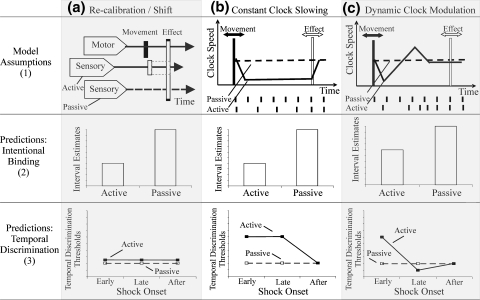Fig. 2.
Models of subjective time. a Recalibration/time-shift. (1) The perceived time of anticipated effects following voluntary movements is shifted backwards in time towards the action that caused them. This subjectively shortens action-effect intervals relative to passive control conditions (2), but clock speed remains unchanged, and so therefore does temporal discrimination (3). b Constant clock slowing. (1) Operant movements reduce clock speed throughout the action-effect interval. (2) Because fewer clock ticks accumulate, the action-effect interval appears shorter following active than passive movements. (3) Clock slowing also impairs temporal discrimination during the action-effect interval, as the interval required to resolve successive stimuli is increased. c Dynamic clock modulation. (1) Initial clock slowing is followed by an increase of clock rate that partially compensates for the “lost” time. If compensation is underpowered, action-effect intervals seem shorter than after passive movements (2), but early impairments in temporal discrimination are followed by compensatory improvements (3)

